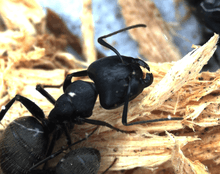Blochmannia
Blochmannia is a genus of symbiotic bacteria found in carpenter ant. There are over 1000 species of these ants and, as of 2014, of the over 30 species of carpenter ant that have been investigated, all contain some form of Blochmannia.[2][3] The bacteria filled cells currently known as members of the genus Blochmannia were first discovered by zoologist F. Blochmann in the ovaries and midguts of insects in the 1880s.[4][5] In 2000 Candidatus Blochmannia was proposed as its own genus.[5]
| Blochmannia[1] | |
|---|---|
| Scientific classification | |
| Kingdom: | |
| Phylum: | |
| Class: | Gamma Proteobacteria |
| Order: | |
| Family: | |
| Genus: | Candidatus Blochmannia |

Endosymbiosis, or when the Blochmannia bacteria and the ant hosts became bonded, occurred around 30–40 million years ago.[2] In comparing two species of Blochmannia that diverged evolutionarily around 15-20 million years ago, the extreme similarity between their genes means Blochmannia bacteria have high levels of genetic conservation.[6] The high amounts of genetic conservation suggest that the Blochmannia genes lack some recombination mechanisms.[6]
Blochmannia bacteria are found in the midguts of carpenter ants, as well as the ovaries of the female carpenter ants.[4] Blochmannia is important in synthesizing essential and non essential amino acids, including tyrosine, and it helps the ant to process nitrogen.[2][7] The Blochmannia bacteria improves the ants’ nutrition and, in doing this, it is also important to the overall health of the ant colony.[7] According to the study by Zientz et al., Blochmannia improves the health of the colony of ants as a whole because worker ants use a "trophallaxis and regurgitation" system to provide the colony with food.[7] When control colonies which had Blochmannia were compared to groups where the worker ants had been given antibiotics to reduce their levels of Blochmannia , the health of the control colony was superior.[7] Zientz proposes that this superior fitness of the control ant colonies is likely due to Blochmannia improving the nutritional quality of the food that worker ants supply to the young ants, as the health effects of Blochmannia appear to decrease with the ant's maturation.[7]
Blochmannia bacteria are sensitive to heat. In one experiment, when exposed to an increased heat of 99.87 °F (37.7 °C) for 4 weeks, over 99% of Blochmannia disappeared.[8] However, even after 16 weeks exposure of this heat exposure, trace small amounts of Blochmannia survived.[8] According to researchers Fan and Wernegreen, this experiment suggests that the Blochmannia in ants could be vulnerable to the effects of global warming.[8]
References
- "Candidatus Blochmannia floridanus (Candidatus Blochmannia floridanus) Genome Browser Gateway". The UCSC Genome Browser. Genome Bioinformatics Group of UC Santa Cruz.
- Feldhaar, Heike; Straka, Josef; Krischke, Markus; Berthold, Kristina; Stoll, Sascha; Mueller, Martin; Gross, Roy (2007). "Nutritional upgrading for omnivorous carpenter ants by the endosymbiont Blochmannia". BMC Biology. 5 (1): article #48. doi:10.1186/1741-7007-5-48. PMC 2206011. PMID 17971224.
- He, Hong; Wei, Cong; Wheeler, Diana (20 April 2014). "The Gut Bacterial Communities Associated with Lab-Raised and Field-Collected Ants of Camponotus fragilis (Formicidae: Formicinae)". Current Microbiology. 69 (3): 292–302. doi:10.1007/s00284-014-0586-8. PMID 24748441.
- Sauer, Christina; Dudaczek, Dieter; Hölldobler, Bert; Gross, Roy (September 2002). "Tissue Localization of the Endosymbiotic Bacterium "Candidatus Blochmannia floridanus" in Adults and Larvae of the Carpenter Ant Camponotus floridanus". Applied and Environmental Microbiology. 68 (9): 4187–4193. doi:10.1128/AEM.68.9.4187-4193.2002. PMC 124124. PMID 12200264.
- Sauer, Christina; Stackebrandt, Erko; Gadau, Jürgen; Hölldobler, Bert; Gross, Roy (2000). "Systematic relationships and cospeciation of bacterial endosymbionts and their carpenter ant host species: proposal of the new taxon Candidatus Blochmannia gen. nov". International Journal of Systematic and Evolutionary Microbiology. 50 (5): 1877–1886. doi:10.1099/00207713-50-5-1877. PMID 11034499.
- Degnan, Patrick; Lazarus, Adam; Wernegreen, Jennifer (August 2005). "Genome sequence of Blochmannia pennsylvanicus indicates parallel evolutionary trends among bacterial mutualists of insects". Genome Research. 15 (8): 1023–1033. doi:10.1101/gr.3771305. PMC 1182215. PMID 16077009.
- Zientz, Evelyn; Beyaert, Ivo; Gross, Roy; Feldhaar, Heike (September 2006). "Relevance of the Endosymbiosis of Blochmannia floridanus and Carpenter Ants at Different Stages of the Life Cycle of the Host". Applied and Environmental Microbiology. 72 (9): 6027–6033. doi:10.1128/AEM.00933-06. PMC 1563639. PMID 16957225.
- Fan, Yongliang; Wernegreen, Jennifer (October 2013). "Can't Take the Heat: High Temperature Depletes Bacterial Endosymbionts of Ants". Microbial Ecology. 66 (3): 727–733. doi:10.1007/s00248-013-0264-6. PMC 3905736. PMID 23872930.